 |
Preparing the wood for drones and chanter
(updated 08/02/16) |
(8th February 2016) The following section is an update of the original text with new pictures added. I am currently making several new sets and taking this opportunity to check the drawings and update the text with better pictures.
One change to my method of mounting the blank for drilling has been made possible by the acquisition of a self centering 4 jaw chuck. I used to turn the blank to a full cylinder before drilling but I now only turn enough to enable mounting in the 4jaw chuck. The main benefit is that I can use smaller sizes of wood as the full size of the square is available and any run-out of the drilling more easily catered for.
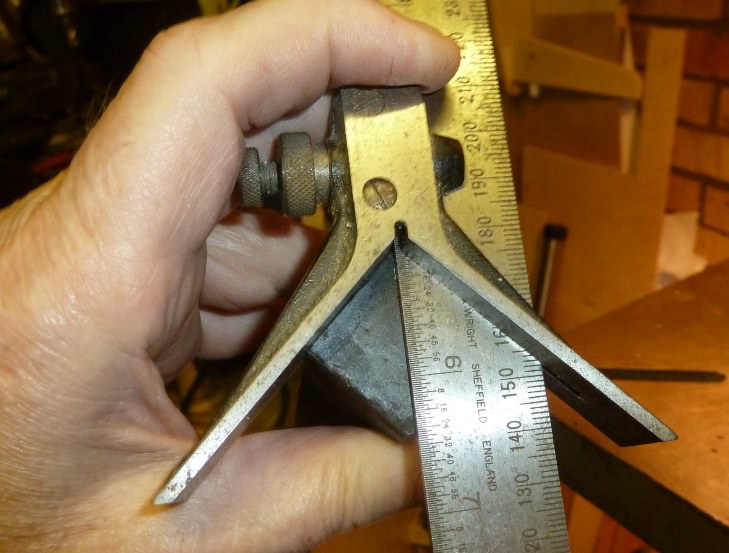
The centre of the blank is scribed using a combination centre as shown. |
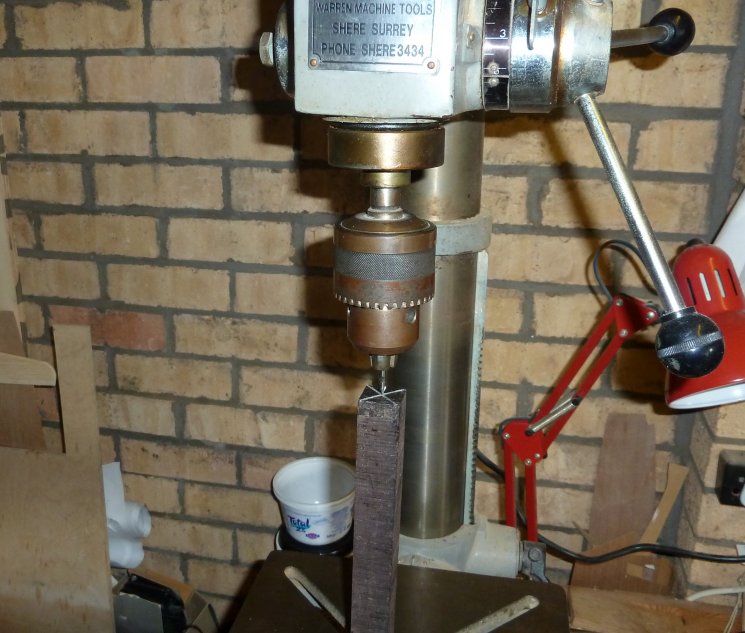
The blank is centre drilled in a pillar drill both ends after centre punching the intersection of the scribed lines |
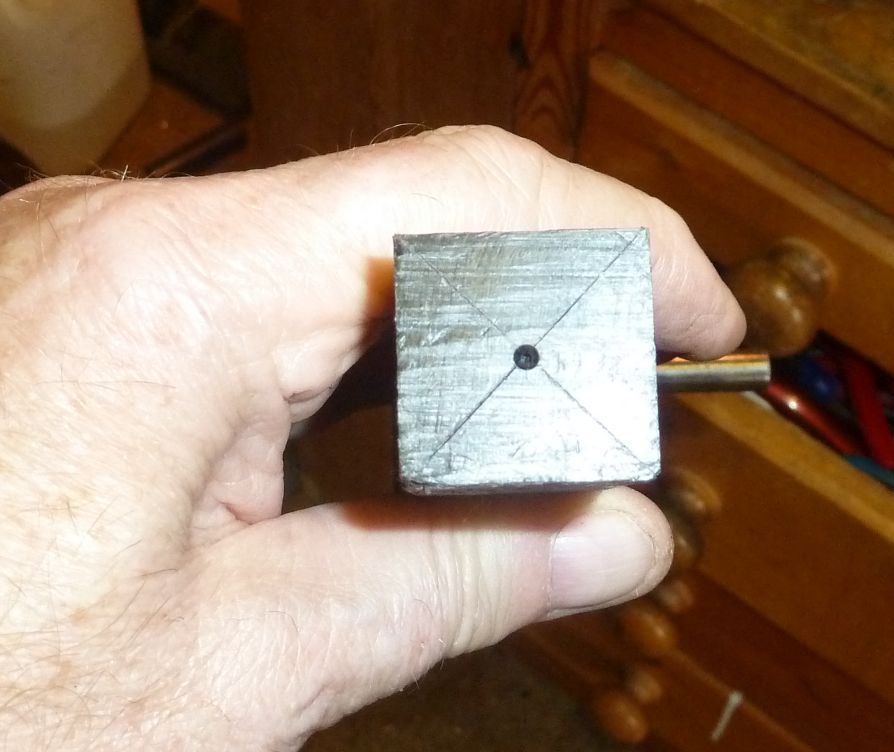
The centre drill should be exactly centred on the intersection of the 2 scribed lines both ends. |
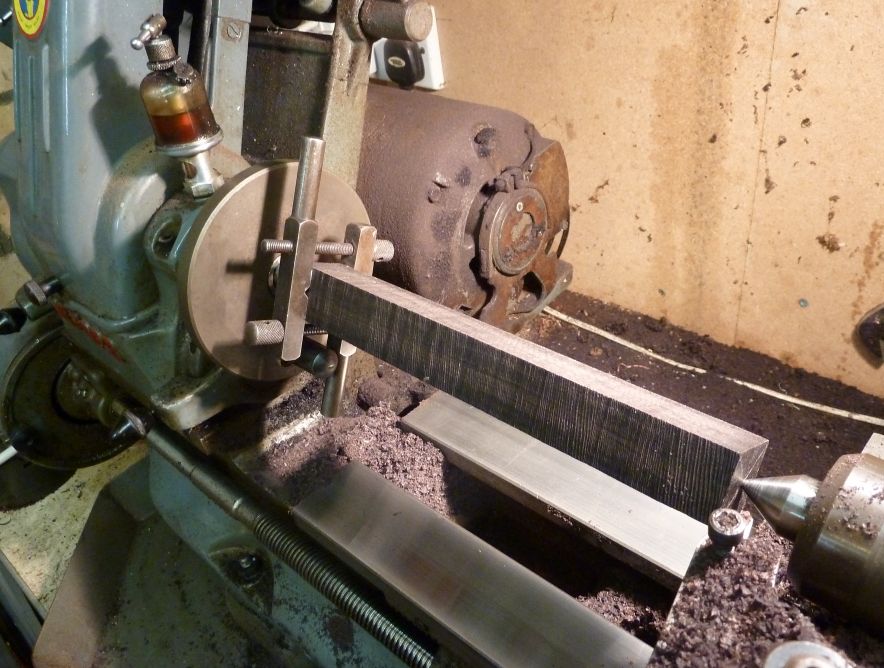
The blank is set up between centres on the lathe ready for the first turning operation |
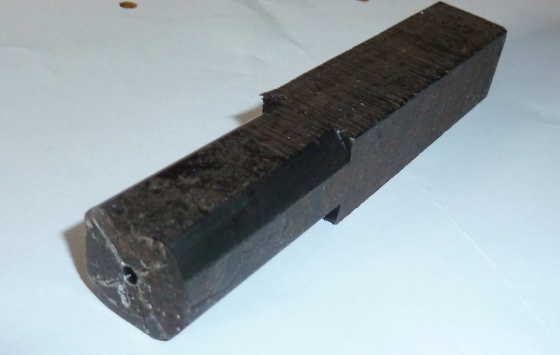
The blank is turned enough to make accurate mounting in the self-centering 4 jaw chuck easy |
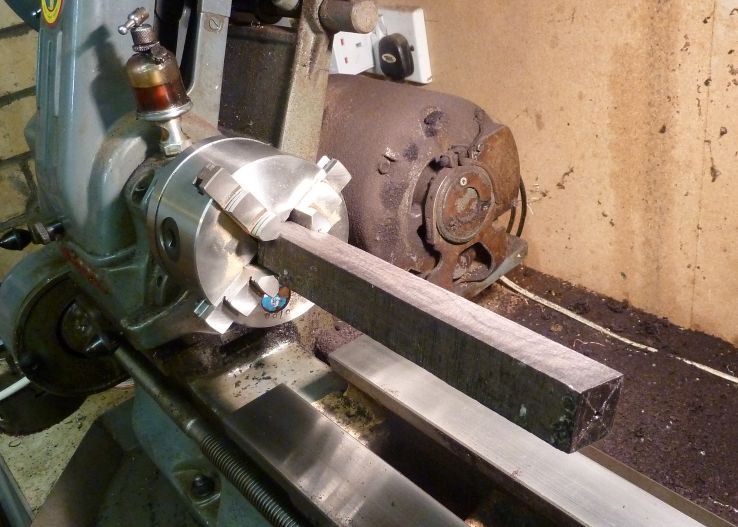
The blank is mounted in the 4 jaw chuck and checked to ensure it is running perfectly true. |
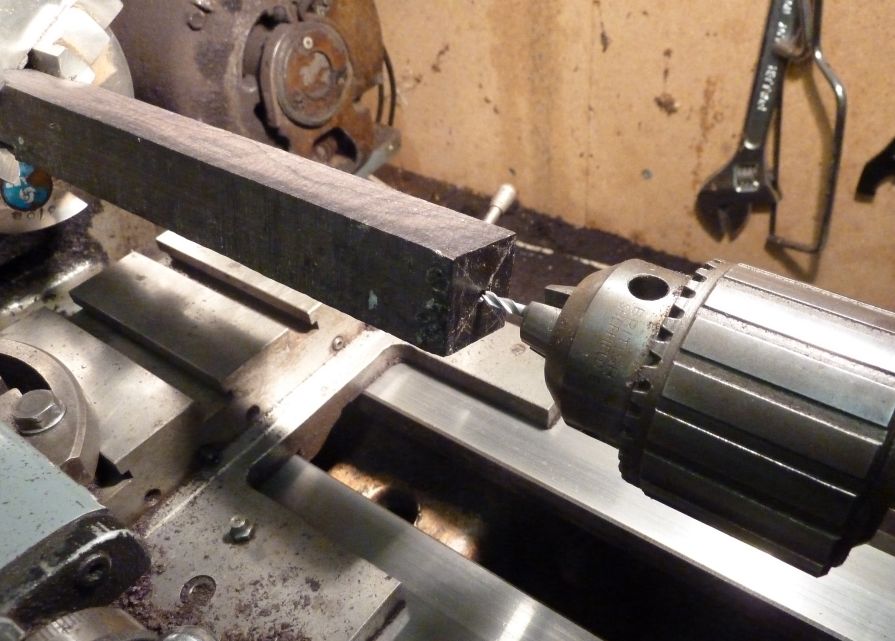
The starting hole is machined with a slot drill of the appropriate size - this must be perfectly centred!! |
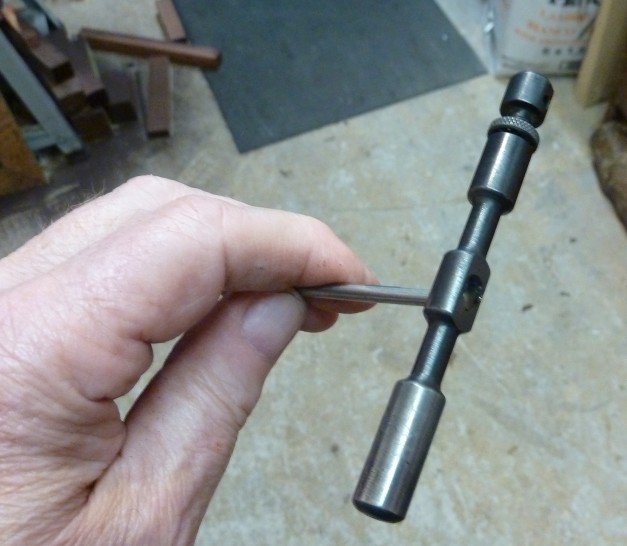
The "D"bit drill is held in a tap wrench to make the insertion and control easy. |
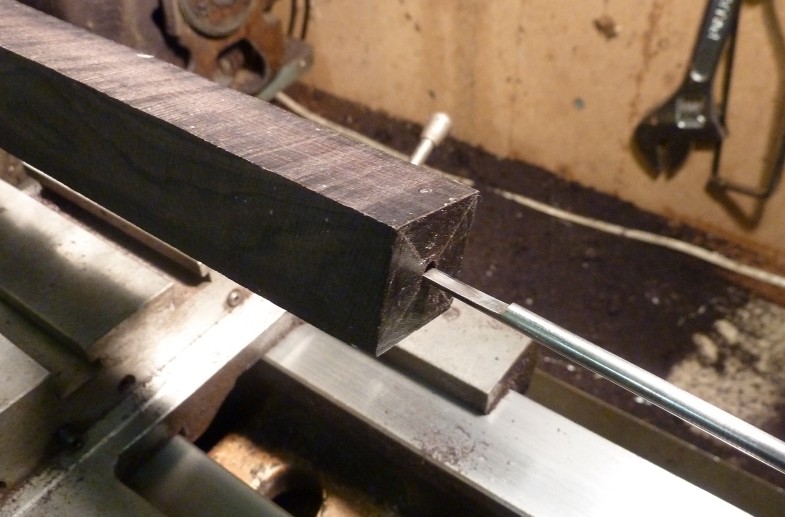
The tailstock has been removed and the drill can be entered into the starting hole by hand. |
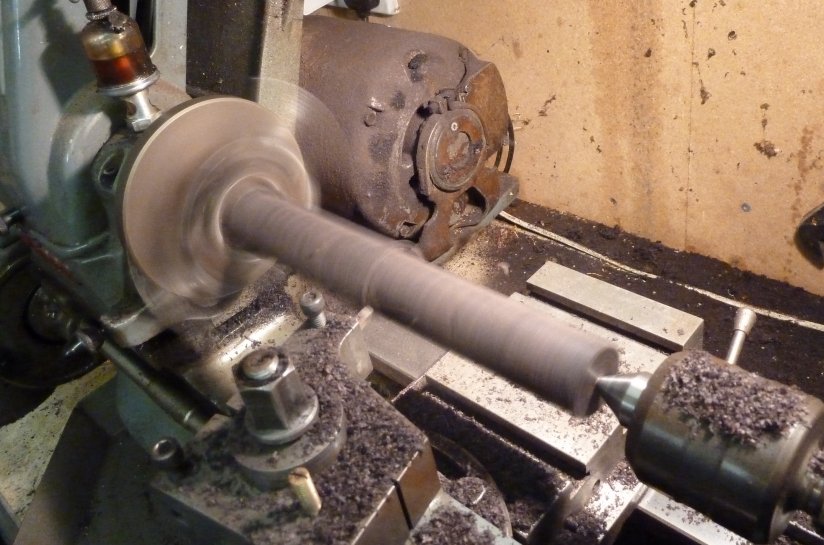
Once the chanter is drilled it can be mounted between centres and turned to a full diameter. I usually leave this oversize until the bore has been reamed and I am ready to turn the chanter. |
Preparing the blank
The wood should be cut to length being sure to keep the ends as square as possible. The centre point of each end is then found, centre punched and centre drilled using a No. 2
'Slocombe' centre drill. The blank is mounted between centres in the lathe, and turned to the largest cylinder possible. This should be at least 3mm larger than the final diameter and more if possible. If you have a four-jaw chuck, the blank can be mounted in its square condition and the bore drilled before the outside is turned. However I have found that this is not necessary if the drilled hole is well centred and the wood of sufficient size to turn to an outside diameter of 22/25mm. The larger the diameter the more the bore of the chanter can be allowed to drift out of alignment during the drilling before the blank is ruined.
Drilling the bore
The blank is gripped in a three-jaw chuck. The free end is checked to ensure that the centre drilled hole is running centrally. If it is more than a tiny amount off centre, adjust the mounting in the chuck until any visible excentricity is corrected. When the blank is running centrally, drill a pilot hole EXACTLY on the centre which is the same diameter as the bore of the chanter (Ø4.0mm). This pilot hole is drilled about 12mm/15mm deep. It is VITAL that this hole is as accurate as possible as any errors here will be amplified during the drilling of the rest of the bore. A technique that I use to ensure a central hole is to follow the centre drill with a Ø3.5mm drill and then open it out to size using a good Ø4.0mm slot drill gripped in the tailstock chuck. A further trick is to place a piece of paper under one of the jaws of the tailstock chuck. This will push the Ø4.0mm slot drill enough off centre to ensure that only one of its cutting edges is active, thus acting as a very stiff single point boring tool and reducing any chance of the pilot hole wandering off centre.
The 'D' bit drill is held in a tap wrench and guided into the prepared hole by hand. This does does take some care to ensure that the initial accuracy is not compromised. I used to use a guide in the tailstock but I have found that this is not necessary and the process is much simplified if guiding through the tailstock is dispensed with.
Old method for reference only. If the lathe used is one of the older types of lathe with a 'through hole' tailstock, eg:- the early Myford® ML7, a bush can be put in this hole and the drill guided through this into the wood. This will make the first 50mm to 100mm easier after which the tailstock can be removed and the remaining drilling completed freehand. If the lathe used does not have a through hole, a guide can be made and fitted to the lathe bed. However, care must be taken to ensure that it can be fitted and dismounted whilst maintaining its accuracy.
The lathe should be run at about 600 R.P.M. (Note this is the max speed of my Myford ML7 so faster may be better) and the drill fed gently into the wood using only a light hand pressure. The cutting should proceed in steps of about 2 or 3mm. After each step the drill must be removed from the hole and the plug of swarf flicked off the end. The swarf should fill only about 3/4 of the space on the flat of the 'D' If the space is filled completely the amount that the drill is advanced each step should be reduced as there is a danger of the hole either being forced off-centre or a chamber being created. As the drilling proceeds the drill may start to bind in the hole. This can be eased by rubbing the drill on a block of beeswax.
If the friction becomes too great it is an indication that the hole being drilled is slightly smalled than the shank of the drill. I have had some success in relieving this by rubbing the shank of the drill with emery paper thus slightly reducing its diameter.
Another common problem is difficulty in extracting the plug of swarf. This is caused either by the swarf holding feature on the drill being too shallow to hold the plug of swarf securely, or the hole is not being advanced sufficiently at each step to create a plug packed down into the holding feature. This problem can also be caused by the drill cutting undersize causing the plug to be pulled off the drill by friction. The solution to this is to run a 'D' bit reamer the same nominal size as the drill into the hole thus increasing the bore diameter very slightly and allowing the plug easy passage out of the bore.
I aim to have a runout of less than 1mm in the length of the chanter and have often achieved half of this. I cannot stress strongly enough that the straightness of the final bore is established in the first 12mm of the drilling and time spent getting this right will be rewarded with a good bore that will make the chanter easier to tune and play.
I would recommend starting the drilling with the shortest drone and progressing up through the lengths. This will allow enough practice to enable the chanter bore to be drilled with a greater degree of confidence.
Finishing the Bore
Once the bore has been drilled to Ø4.0mm it is necessary to ream the bore to its final diameter of Ø4.3mm (11/64"). To do this I have increased the length of an 11/64" hand reamer.

To extend the length of the hand reamer I turn down the square socket on the end to about Ø2.5mm. it is usually possible to do this as the end of the reamer is usually left soft. If it is hard it can be softened by heating just the square end up to red heat and allowing it to cool as slowly as possible (withdraw it from the flame very slowly. This should leave it soft enough to turn down in the lathe.
Drill a hole to fit the turned down part of the reamer in a length of Ø4mm silver steel, long enough to ensure that the reamer goes all the way through the chanter and silver solder together making sure that the 2 parts are concentric and parallel.
I have found that it is necessary to remove the reamer from the bore several times and clear out the swarf using the Ø4mm drill. You should find that the resulting bore is accurate and highly polished.
Go to the chanter machining page
Back to Introduction page index
Back to Index page
© Mike Nelson. All rights reserved.
This manual has been put together by Mike Nelson for his own amusement :)
Go back to Mike Nelsons Home Page
This site is created and maintained by Mike Nelson for his own pleasure
© 1997 Mike Nelson


